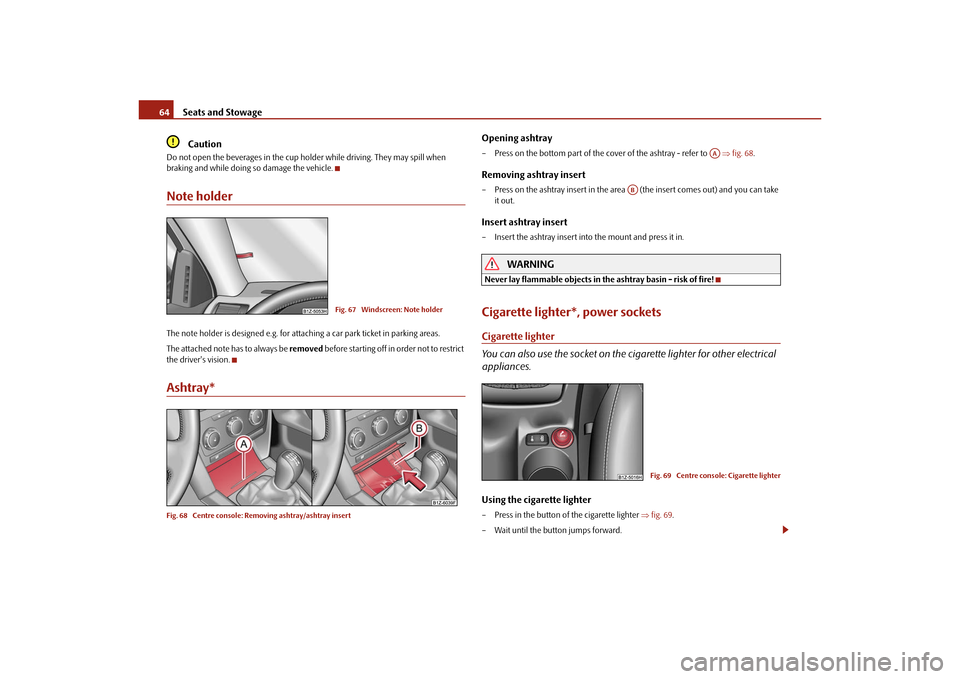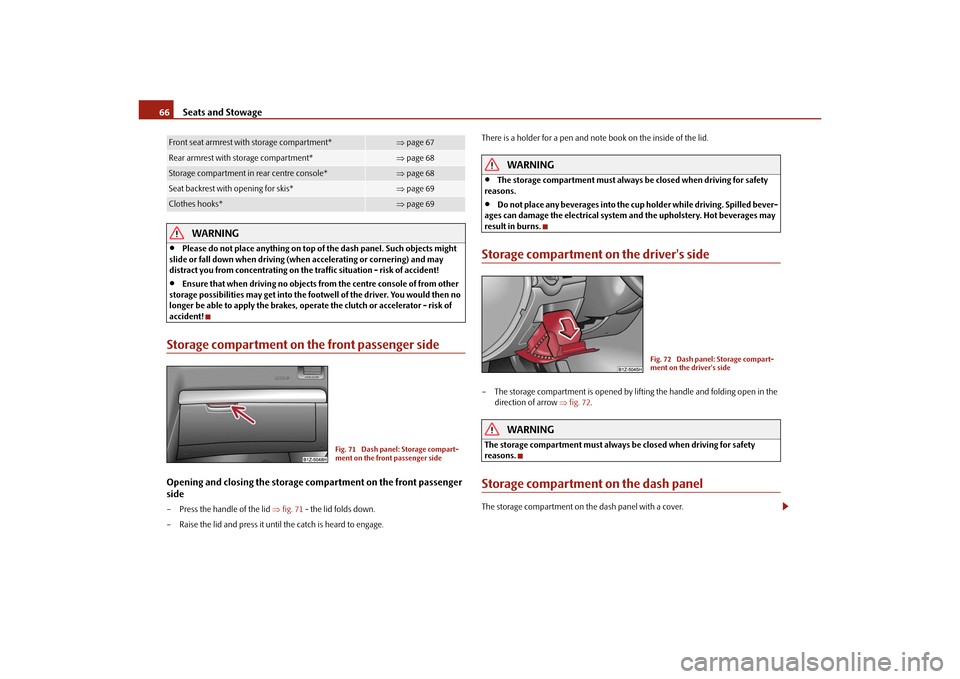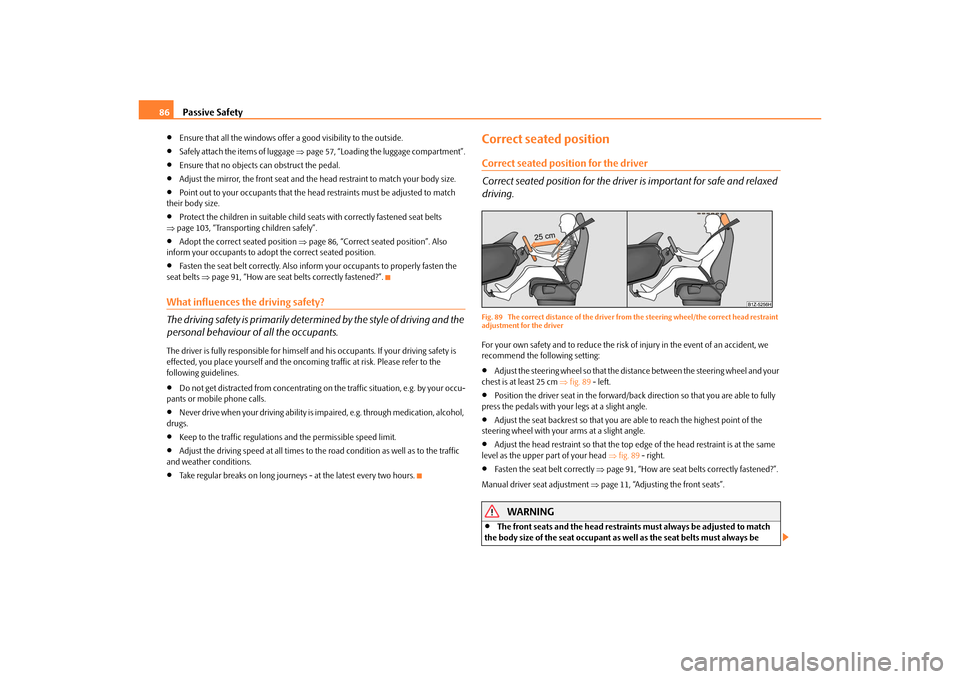2010 SKODA OCTAVIA TOUR seats
[x] Cancel search: seatsPage 65 of 199

Seats and Stowage
64Caution
Do not open the beverages in the cup hold er while driving. They may spill when
braking and while doing so damage the vehicle.Note holderThe note holder is designed e.g. for atta ching a car park ticket in parking areas.
The attached note has to always be removed before starting off in order not to restrict
the driver's vision.Ashtray*Fig. 68 Centre console: Removing ashtray/ashtray insert
Opening ashtray– Press on the bottom part of the cover of the ashtray - refer to fig. 68 .Removing ashtray insert– Press on the ashtray insert in the area (the insert comes out) and you can take
it out.Insert ashtray insert– Insert the ashtray insert into the mount and press it in.
WARNING
Never lay flammable objects in the ashtray basin - risk of fire!Cigarette lighter*, power socketsCigarette lighter
You can also use the socket on the ci garette lighter for other electrical
appliances.Using the cigarette lighter– Press in the button of the cigarette lighter fig. 69 .
– Wait until the button jumps forward.
Fig. 67 Windscreen: Note holder
AA
AB
Fig. 69 Centre console: Cigarette lighter
s2bs.2.book Page 64 Monday, September 27, 2010 9:53 AM
Page 66 of 199

Seats and Stowage65
Using the system
Safety
Driving Tips
General Maintenance
Breakdown assistance
Technical Data
– Remove the cigarette lighter immediately and use it.
– Insert the cigarette lighter again into the socket.
Using the socket– Remove the cigarette lighter or the cover of the power socket.
– Connect the plug of the electrical appliance to the socket.
The 12 volt power socket can also be used
to supply power to additional electrical
accessories with a power uptake up to 120 watts.
WARNING
Take care when using the cigarette ligh ter! Not paying proper attention or
incorrect use the cigarette lighter in an uncontrolled manner may result in
burns.
The cigarette lighter and the power socket also operates when the ignition is
switched off or the ignition key withdrawn. You should therefore never leave
children unattended in the vehicle.Caution
Always use matching plugs to avoid damagi ng the power socket.
Note
Connecting electrical components when the engine is not running will drain
the battery of the vehicle - risk of battery draining!
Further information page 157, “Accessories, changing and replacing parts”.
Power socket in the luggage compartment (Combi)– Open the cover of the power socket fig. 70 .
– Connect the plug of the electrical appliance to the socket.
You can only use the power socket for the connection of approved electrical accesso-
ries with a power uptake up to 120 watts. The vehicle battery will be discharged in the
process if the engine is stationary.
The same remarks apply here as for page 64, “Cigarette lighter*, power sockets”.
Further information page 157, “Accessories, changing and replacing parts”.Storage compartmentsOverviewYou will find the following storag e facilities in your vehicle:Storage compartment on the front passenger side
page 66
Storage compartment on the driver's side
page 66
Storage compartment on the dash panel
page 66
Storage compartment in front centre console*
page 67
Storage compartment in the front doors
page 67
Fig. 70 Luggage compartment: Power
socket
s2bs.2.book Page 65 Monday, September 27, 2010 9:53 AM
Page 67 of 199

Seats and Stowage
66WARNING
Please do not place anything on top of the dash panel. Such objects might
slide or fall down when driving (when accelerating or cornering) and may
distract you from concentrating on the traffic situation - risk of accident!
Ensure that when driving no objects from the centre console of from other
storage possibilities may get into the footwell of the driver. You would then no
longer be able to apply the brakes, operate the clutch or accelerator - risk of
accident!
Storage compartment on the front passenger sideOpening and closing the storage com partment on the front passenger
side– Press the handle of the lid fig. 71 - the lid folds down.
– Raise the lid and press it until the catch is heard to engage. There is a holder for a pen and note book on the inside of the lid.
WARNING
The storage compartment must always be closed when driving for safety
reasons.
Do not place any beverages into the cu p holder while driving. Spilled bever-
ages can damage the electrical system and the upholstery. Hot beverages may
result in burns.
Storage compartment on the driver's side– The storage compartment is opened by li fting the handle and folding open in the
direction of arrow fig. 72 .
WARNING
The storage compartment must always be closed when driving for safety
reasons.Storage compartment on the dash panelThe storage compartment on the dash panel with a cover.
Front seat armrest with storage compartment*
page 67
Rear armrest with storage compartment*
page 68
Storage compartment in rear centre console*
page 68
Seat backrest with opening for skis*
page 69
Clothes hooks*
page 69
Fig. 71 Dash panel: Storage compart-
ment on the front passenger side
Fig. 72 Dash panel: Storage compart-
ment on the driver's side
s2bs.2.book Page 66 Monday, September 27, 2010 9:53 AM
Page 68 of 199

Seats and Stowage67
Using the system
Safety
Driving Tips
General Maintenance
Breakdown assistance
Technical Data
WARNING
The storage compartment is not a substi tute for the ashtray and must also
not be used for such purposes - risk of fire!
Do not put any highly inflammable obje cts or objects which are sensitive to
heat (e.g. lighters, spra ys, spectacles, carbonated drinks) in the storage
compartment.
During the journey, no objects must be in the storage compartment. In the
event of a vehicle collision these objects could be thrown out of the compart-
ment - risk of injuries!
Storage compartment in front centre console*– Press on the bottom part of the storage compartment in the area fig. 73 - the
lid opens.
WARNING
The storage compartment is not a substitu te for the ashtray and must also not
be used for such purposes - risk of fire!
Storage compartment in the front doorsA bottle holder is located in the area of the storage compartment for the front
doors.
WARNING
Use the area page 67, fig. 74 of the storage compar tment only for storing
objects which do not project so that the effectiveness of the side airbag is not
impaired.Front seat armrest with storage compartment*Fig. 75 Armrest: Storage compartm ent/cooling of storage compartmentThe armrest is adjustable for height and length.
Fig. 73 Front centre console: Storage
compartment
AA
Fig. 74 Storage compartment in the
front doors
AB
AA
s2bs.2.book Page 67 Monday, September 27, 2010 9:53 AM
Page 69 of 199

Seats and Stowage
68
Opening storage compartment
– Open the lid of the armrest in the direction of arrow fig. 75 - left.Closing storage compartment– Open the lid up to the stop, then you can fold it downwards.Setting height– First of all fold the lid to the bottom and lift it in the direction of arrow into one of
the 4 fixed positions.Adjusting in forward/back direction– Push the lid into the desired position.Opening air inlet– Pull the lock in upward direction.Closing air inlet– Push the lock as far as the stop downwards.
On vehicles fitted with ai r conditioning, the storage co mpartment is equipped with a
lockable inlet for thermally treated (warmed-up) air.
At open air supply, air flows into the storag e with a temperature which is as high as the
one out of the air outlet nozzles, depending on temperature setting.
The air inlet in the storage compartment is connected to position
through adjust-
ment of the control dial for air distribution. This position causes the maximum amount
of air to flow into the storage compartmen t (depending on the rotary regulator posi-
tion for the fan).
You can use the storage compartment, for example, to temper drinks cans, etc.
If you do not use the air inlet in the storage compartment, the end cover should
always be kept closed.
Note
Push the lid of the armrest up to stop to the rear before operating the handbrake.
Rear seat armrest with storage compartment*A storage compartment* is located in the armrest. You open the compartment by
pressing the button on the front side and raising the cover page 68, fig. 76 .Storage compartment in rear centre console*The storage compartment is equipped with a removable insert.
– Open the storage compartment by pullin g on the upper edge of the storage
compartment in the direction of arrow fig. 77 .
WARNING
The storage compartment is not a substitute for the ashtray and must also not
be used for such purposes - risk of fire!
AAAA
Fig. 76 Armrest of rear seats:Fig. 77 Centre console at rear: Storage
compartment
AA
s2bs.2.book Page 68 Monday, September 27, 2010 9:53 AM
Page 70 of 199

Seats and Stowage69
Using the system
Safety
Driving Tips
General Maintenance
Breakdown assistance
Technical Data
Seat backrest with opening for skis*Fig. 78 Rear seats: Cover handle/l uggage compartment: Unlock buttonAfter folding open the armrest and the lid, an opening in the seat backrest becomes
visible through which you can push long objects e.g. skis etc. You can fold open the
armrest and the lid from the passenger or luggage compartment.Opening from passenger compartment– Pull down the armrest of the rear seat at the loop page 55.
– Pull the handle up to the stop in upward direction and fold open the lid downwards fig. 78 - left.Opening from luggage compartment– Push the unlock button downwards fig. 78 - right and fold the lid (with armrest)
to the front.Closing– Fold the cover and the arm rest upwards as far as the stop. The cover must click into
place audibly.
Ensure that the armrest is always locked into place after closing. You can recognise this
on the fact that the red field above the unlocking button of the luggage compartment
is not visible.
Clothes hooks*The clothes hooks are located on the middle pillar and on the handle in the headliner
above each of the rear doors.
WARNING
Ensure that any clothes hanging from the hooks do not impair your vision to
the rear.
Use the hooks for hanging only light item s of clothing and ensure that there
are no heavy or sharp-edged objects in the pockets.
The maximum permissible load of the hooks is 2 kg.
Do not use clothes hangers for hanging up items of clothing otherwise this
will interfere with the protection offered by the head airbag*.
s2bs.2.book Page 69 Monday, September 27, 2010 9:53 AM
Page 86 of 199

Passive Safety85
Using the system
Safety
Driving Tips
General Maintenance
Breakdown assistance
Technical Data
SafetyPassive SafetyBasic informationDriving the safe way
Passive safety measures reduce the risk of injury in accident situations.In this section you will find important info rmation, tips and notes on the subject of
passive safety in your vehicle. We have combined everything here which you should
be familiar with, for example, regarding seat belts, airbags, child seats and safety of
children. It is therefore important, in partic ular, to comply with the notes and warnings
in this section for your own interest and in the interest of those travelling with you.
WARNING
This chapter contains important information on how to use the vehicle for
the driver and his occupants. You will find further information on safety, which
concerns you and those travelling with you, in the following chapters of this
Owner's Manual.
The complete on-board literature should always be in the vehicle. This
applies in particular, if you rent out or sell the vehicle.
Safety equipment
The safety equipment is part of the occupant protection and it can
reduce the risk of injuries in accident situations.“Do not put at risk” your safety and the safety of those travelling with you . In the event
of an accident, the safety equipment can redu ce the risk of injuries. The following list
contains part of the safety equipment in your vehicle:
Three-point seat belts for all the seats,
belt force limiter for front seats and outer rear seats*,
belt tensioner for front seats,
seat belt height adjuster for front seats,
front airbag for the driver and the front seat passenger*,
side airbags*,
head airbags*,
anchoring points for child seat using the “ISOFIX” system,
anchoring points for child seat using the “Top Tether” system,
head restraint adjustable for height,
adjustable steering column.
The specified safety equipment works togeth er, in order to optimally protect you and
those travelling with you in accident situat ions. The safety equipment does not protect
you or the people travelling with you, if you or your occupants adopt an incorrect
seated position or the equipment is not correctly adjusted or used.
For this reason you will be provided with information on why this equipment is very
important, how it protects you and the occupants, what should be observed when
using the equipment and how you and the peop le travelling with you can make full use
of the existing safety equipment. This Owner's Manual contains important warning
notes, which you and those travelling with you should pay attention to in order to
reduce a risk of injury.
Safety concerns everybody!
Before setting off
The driver is always fully responsibl e for his occupants and for the oper-
ating safety of the vehicle.For your own safety and the safety of the pe ople travelling with you, please pay atten-
tion to the following points before setting off:
Ensure that the lighting and the turn signal system are functioning properly.
Inspect the tyre inflation pressure.
s2bs.2.book Page 85 Monday, September 27, 2010 9:53 AM
Page 87 of 199

Passive Safety
86
Ensure that all the windows offer a good visibility to the outside.
Safely attach the items of luggage page 57, “Loading the luggage compartment”.
Ensure that no objects can obstruct the pedal.
Adjust the mirror, the front seat and the head restraint to match your body size.
Point out to your occupants that the head restraints must be adjusted to match
their body size.
Protect the children in suitable child seats with correctly fastened seat belts
page 103, “Transporting children safely”.
Adopt the correct seated position page 86, “Correct seated position”. Also
inform your occupants to adopt the correct seated position.
Fasten the seat belt correctly. Also inform your occupants to properly fasten the
seat belts page 91, “How are seat belts correctly fastened?”.
What influences the driving safety?
The driving safety is primarily determined by the style of driving and the
personal behaviour of all the occupants.The driver is fully responsible for himself an d his occupants. If your driving safety is
effected, you place yourself and the oncomi ng traffic at risk. Please refer to the
following guidelines.
Do not get distracted from concentrating on the traffic situation, e.g. by your occu-
pants or mobile phone calls.
Never drive when your driving ability is impaired, e.g. through medication, alcohol,
drugs.
Keep to the traffic regulations and the permissible speed limit.
Adjust the driving speed at all times to the road condition as well as to the traffic
and weather conditions.
Take regular breaks on long journe ys - at the latest every two hours.
Correct seated positionCorrect seated position for the driver
Correct seated position for the driver is important for safe and relaxed
driving.Fig. 89 The correct distance of the driver fr om the steering wheel/the correct head restraint
adjustment for the driverFor your own safety and to reduce the risk of injury in the event of an accident, we
recommend the following setting:
Adjust the steering wheel so that the distance between the steering wheel and your
chest is at least 25 cm fig. 89 - left.
Position the driver seat in the forward/back direction so that you are able to fully
press the pedals with your legs at a slight angle.
Adjust the seat backrest so that you are able to reach the highest point of the
steering wheel with your arms at a slight angle.
Adjust the head restraint so that the top edge of the head restraint is at the same
level as the upper part of your head fig. 89 - right.
Fasten the seat belt correctly page 91, “How are seat belts correctly fastened?”.
Manual driver se at adjustment page 11, “Adjusting the front seats”.
WARNING
The front seats and the head restraints must always be adjusted to match
the body size of the seat occupant as well as the seat belts must always be
s2bs.2.book Page 86 Monday, September 27, 2010 9:53 AM